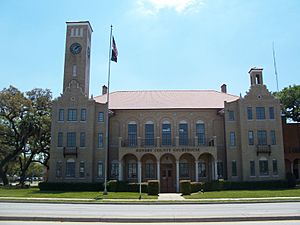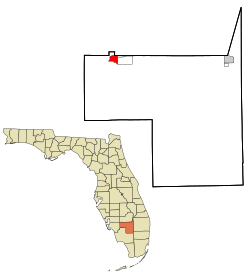LaBelle, Florida facts for kids
Quick facts for kids
LaBelle, Florida
|
||
|---|---|---|

Old Hendry County Courthouse
|
||
|
||
| Nickname(s):
The Belle of the Caloosahatchee
|
||
| Motto(s):
"The City Under the Oaks"
|
||

Location in Hendry County and the state of Florida
|
||
| Country | ||
| State | ||
| County | Hendry | |
| Incorporated | 1925 | |
| Area | ||
| • Total | 14.59 sq mi (37.78 km2) | |
| • Land | 14.49 sq mi (37.52 km2) | |
| • Water | 0.10 sq mi (0.25 km2) | |
| Elevation | 13 ft (4 m) | |
| Population
(2020)
|
||
| • Total | 4,966 | |
| • Density | 342.79/sq mi (132.35/km2) | |
| Time zone | UTC-5 (Eastern (EST)) | |
| • Summer (DST) | UTC-4 (EDT) | |
| ZIP codes |
33935, 33975
|
|
| Area code(s) | 863 | |
| FIPS code | 12-37225 | |
| GNIS feature ID | 0285188 | |
LaBelle is a city in Hendry County, Florida, United States. It is also the county seat, which means it's where the main government offices for the county are located. In 2020, about 4,966 people lived there. LaBelle is part of the Clewiston, FL Micropolitan Statistical Area.
The city got its name from two sisters, Laura June Hendry and Carrie Belle Hendry. They were the daughters of a famous cattle rancher named Francis Asbury Hendry.
LaBelle is known for its yearly Swamp Cabbage Festival. This fun event celebrates the Sabal palmetto, which is Florida's state tree. The festival happens every year during the last full weekend of February.
Contents
History of LaBelle
Early Settlement and Growth
LaBelle started as a small community along the Caloosahatchee River. This was around the time when people like Hamilton Disston were trying to drain the Everglades. They hoped this would help the area grow. The first people to live here were mostly cattle drivers and trappers.
Schools and Education
By 1891, LaBelle had its first school. It was built on the land where the LaBelle School would later stand in 1915. This school was known for its white columns. By 1921, LaBelle school was one of the best schools in Florida. Today, that campus is called Edward A. Upthegrove Elementary School. It's named after one of the first families in LaBelle.
Land and Famous Owners
In 1909, Captain Hendry divided his large land property to sell it. A man named Edgar Everett (E. E.) Goodno bought most of the land. This made LaBelle much bigger, almost twenty times its original size!
Later, in 1924, Henry Ford bought a huge piece of land in LaBelle from E. E. Goodno. Ford had loaned money to Goodno a few years before. Instead of Goodno paying him back, Ford took the land. Goodno continued to manage the property for Ford. They raised different kinds of cattle and even Angora goats there.
Churches and Community
LaBelle's first church was a Methodist church, started in 1891. It soon joined with an older Methodist church nearby. By 1912, LaBelle also had a Baptist church and other churches. People would even have large baptisms in the Caloosahatchee River.
Becoming a City
LaBelle became the county seat of Hendry County in 1923. This meant it became the main town for the county government. In 1925, the state of Florida officially made LaBelle a city. D. A. Mitchell became the first mayor.
For a while, parts of LaBelle were in different counties. In 1929, a part of LaBelle that was in Glades County was moved back into Hendry County. This happened after a public vote. Eight years later, the people in that area voted again to rejoin LaBelle in Hendry County. They felt that the Glades County government was not paying enough attention to them.
Geography and Climate
Location of LaBelle
LaBelle is located in the northwestern part of Hendry County. It sits on the south side of the Caloosahatchee River.
Roads and Travel
Florida State Road 80 goes right through the middle of LaBelle. If you go east on this road, you'll reach Clewiston in about 31 miles. If you go west, you'll get to Fort Myers in about 30 miles.
Florida State Road 29 also crosses SR 80 in LaBelle. This road goes northeast to Palmdale (about 15 miles) and south to Immokalee (about 24 miles).
Land and Water
The city of LaBelle covers a total area of about 14.59 square miles (37.78 square kilometers). Most of this area is land, about 14.49 square miles (37.52 square kilometers). A small part, about 0.10 square miles (0.25 square kilometers), is water.
Climate in LaBelle
LaBelle has a climate with hot and humid summers. The winters are generally warm. This type of weather is called a humid subtropical climate. It's a bit like a tropical savanna climate.
Population Data
| Historical population | |||
|---|---|---|---|
| Census | Pop. | %± | |
| 1920 | 377 | — | |
| 1930 | 397 | 5.3% | |
| 1940 | 837 | 110.8% | |
| 1950 | 945 | 12.9% | |
| 1960 | 1,262 | 33.5% | |
| 1970 | 1,823 | 44.5% | |
| 1980 | 2,287 | 25.5% | |
| 1990 | 2,703 | 18.2% | |
| 2000 | 4,210 | 55.8% | |
| 2010 | 4,640 | 10.2% | |
| 2020 | 4,966 | 7.0% | |
| U.S. Decennial Census | |||
Population Changes (2010 and 2020)
In 2020, LaBelle had 4,966 people living in the city. There were 1,484 households and 1,036 families. Back in 2010, there were 4,640 people, 1,679 households, and 1,203 families.
The table below shows the different groups of people living in LaBelle based on the 2010 and 2020 censuses. "NH" means "Non-Hispanic."
| Race | Pop 2010 | Pop 2020 | % 2010 | % 2020 |
|---|---|---|---|---|
| White (NH) | 2,034 | 1,730 | 43.84% | 34.84% |
| Black or African American (NH) | 359 | 328 | 7.74% | 6.60% |
| Native American or Alaska Native (NH) | 9 | 15 | 0.19% | 0.30% |
| Asian (NH) | 28 | 24 | 0.60% | 0.48% |
| Pacific Islander or Native Hawaiian (NH) | 0 | 1 | 0.00% | 0.02% |
| Some other race (NH) | 7 | 17 | 0.15% | 0.34% |
| Two or more races/Multiracial (NH) | 22 | 71 | 0.47% | 1.43% |
| Hispanic or Latino (any race) | 2,181 | 2,780 | 47.00% | 55.98% |
| Total | 4,640 | 4,966 |
Arts and Culture
The city of LaBelle hosts an exciting annual festival. It celebrates the cabbage palm, which is the state tree. The festival has many fun activities for everyone. These include a 5K walk/run, a beauty pageant, and a rodeo. The main celebrations happen at LaBelle's Barron Park.
Education
LaBelle has a good education system for its students. There are four elementary schools: LaBelle Elementary, Country Oaks Elementary, Edward A. Upthegrove Elementary, and West Glades Elementary. For middle schoolers, there is LaBelle Middle School. Older students attend LaBelle High School. There is also a private school called International Christian Academy of Labelle.
Notable People
Some well-known people have connections to LaBelle:
- Bill Gramática – A former NFL football player who was a place kicker.
- Martín Gramática – Also a former NFL football player and place kicker. He is Bill's brother.
- Mary Hayes Davis – She was important in LaBelle in the 1920s. She published The Hendry County News, worked for the Chamber of Commerce, and owned the LaBelle Theatre.
See also
 In Spanish: LaBelle (Florida) para niños
In Spanish: LaBelle (Florida) para niños


